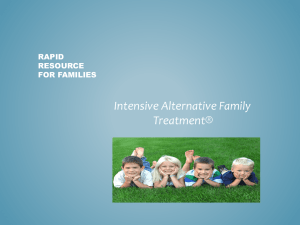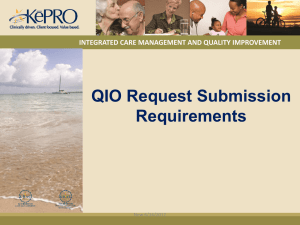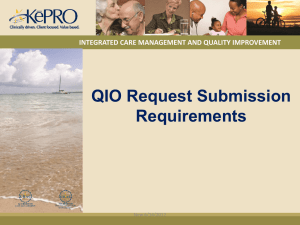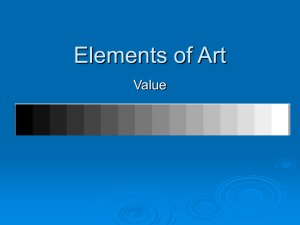CALOCUS - North Sound Mental Health Administration
advertisement
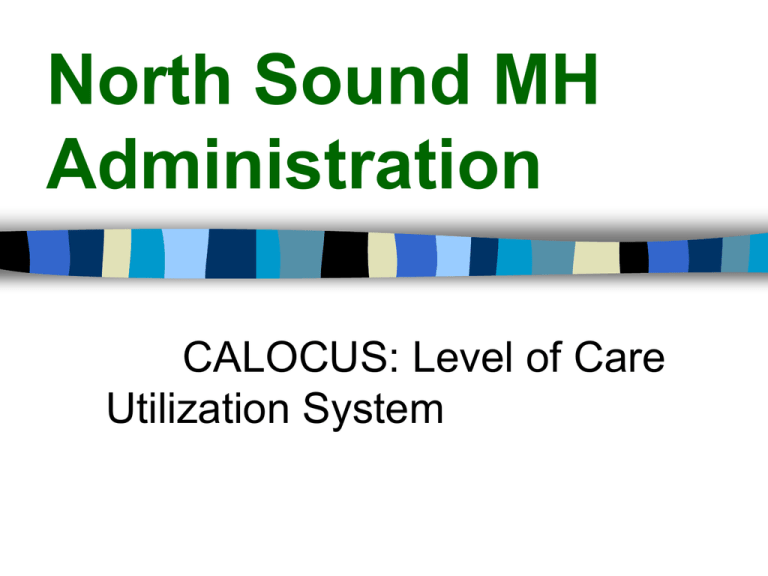
North Sound MH Administration CALOCUS: Level of Care Utilization System Provided by North Sound Mental Health Administration Trainer: Mary Thornton Mary Thornton & Associates, Inc. under contract with Parker Dennison & Associates, Ltd. North Sound CALOCUS Project Acknowledgement: Most of the Materials Used in Developing this Training come from the CALOCUS Manual a publication by the AACP and Deerfield Behavioral Health. Deerfield has also provided answers to our many questions on the CALOCUS and how to score it properly. North Sound CALOCUS Project Introduction: Manual is excellent guide – should be read through at least once by all trainers Manual is a little more political These slides are available and built: – To be used by trainers for internal staff trainings – To be used in conjunction with the tool – Change them to reflect your own agency, agency jargon, and to simplify (may be too much info on history for example) Training is usually 1 day – ½ day is too short and does not allow for practice Can use actual cases rather than Client examples in manual – trainer should pre-score these cases North Sound CALOCUS Project Introduction: May want to mix up cases and use in training both low and high need cases – depends on what levels of care CALOCUS will be used for internally Look at Hints in Red – these are critical scoring issues that if not followed can result in artificially high or low scores. This is not a tool to be used by inexperienced case managers – clinical judgment is critical and may need to be defended. – However, with experience this is an excellent tool to be used by residential, ACT, and other program staff to look at health outcomes and needs over time. – You can choose to use this in all your programs North Sound CALOCUS Project Introduction: Scoring Strategy: – You have options which we will go over later and you need to choose among them. – Authorizing agent require certain data elements and you will want to make sure you capture them. – Ability for agency to look at trended scoring and elements of the scoring are critical for UR – you may want to capture more data than state wants – think about this throughout training today • Is there supposed to be progress in health outcomes? • If progress, where and how is that being built on? • If no progress, why and has strategy been changed? North Sound CALOCUS Project Introduction: Inter-rater reliability: – Will go over in end of training some basic strategies –easier to visualize when you understand tool – Inter-rater reliability is critical long term, not just short term pilot – Annual training and couple of cases scored in groups? North Sound CALOCUS Project Introduction: This tool measures needs at a particular point in time – there are no standards for: – Expectations of Improvement – e.g going from a 3 to a 2 in 3 months is acceptable expectation of improvement – Diagnostic resolution –e.g. movement is expected faster in some diagnostic categories than others – Internal measures of movement along the dimensions is encouraged but not with expectation of linear movement in all or even in most cases – e.g. medical chronic disease model is more appropriate North Sound CALOCUS Project What is the CALOCUS? CALOCUS = Child and Adolescent Level Of Care Utilization System Created by the American Association of Community Psychiatrists Based on CASSP and Systems of Care principals – espouses a full continuum – but still built to be flexible – see handout Also includes within its continuum the concept of “wraparound” or the development of a comprehensive plan for the child and the family of both formal and natural or community supports that build on strengths and provide support where there are weaknesses even if temporary. – Goal is to keep child with family in community North Sound CALOCUS Project What is the CALOCUS? Created in order to provide a tool to: – guide assessment: asking and evaluating relevant data – level of care placement decisions, • Attempt to actually link assessment to need for and focus of treatment – continued stay criteria: less subjective criteria AND same criteria for all levels of care – clinical outcomes: impact of treatment North Sound CALOCUS Project History of CALOCUS Developed to combat problems of poor distribution of treatment resources and idiosyncratic treatment decisions. Wanted consistency in the management of scarce health care resources and ability to utilize efficiently all levels of care “If the adults disagree, the child fails.” Goal is consensus on decision-making for levels of care North Sound CALOCUS Project History of CALOCUS Principles: – Simple: reduce complexity through specificity and the interaction between the composites and the dimensional – Not uni-dimensional – mimics at least to some extent the decision-making process that takes place at assessment – but uses a composite and dimensional scoring to aid in decision-making. – Able to be completed after or during assessment – remove redundancy – Levels of care are flexible – describes resources and intensity not programs – adaptable to any continuum of care – Dynamic model – measures needs over time – eliminates need for separate admission, discharge and continuing stay criteria when using this instrument North Sound CALOCUS Project History of CALOCUS Quantifies the clinical severity and the service needs of children and adolescents with: – Psychiatric disorders – Substance abuse disorders – Developmental disabilities Can integrate one or all three into overlapping clinical issues North Sound CALOCUS Project What is the CALOCUS? There are three basic building blocks of the CALOCUS: – A system for evaluating the current status of clients and their needs based on six evaluation parameters. • 1) Risk of Harm; 2) Functional Status; 3) Medical, Addictive and Psychiatric Co-Morbidity; 4) Recovery Environment; 5) Resiliency and Treatment History; and 6) Acceptance and Engagement. • In each client needs are evaluated using a 5 point scale, with #4 having two subscales and 6 also having 2 subscales with only the highest score being used in the composite. North Sound CALOCUS Project What is the CALOCUS? There are three basic building blocks of the CALOCUS: – An assignment to one of seven levels of care that are defined by descriptions of the: 1) Care Environment, 2) Clinical Services, 3) Support Services, and 4) Crisis Resolution and Prevention Services at each level. North Sound CALOCUS Project What is the CALOCUS? There are three basic building blocks of the CALOCUS: – A methodology for quantifying the assessment of service needs in order to reliably place a client into the service continuum. North Sound CALOCUS Project What is the CALOCUS? The profiler usually first completes the diagnostic assessment of needs and then moves on to assignment to level of care. – Should not need a separate assessment just to complete the CALOCUS North Sound CALOCUS Project CALOCUS: Using the Tool Not diagnostically driven – do not need diagnosis to complete – Looks at needs now – recognizes that some individuals need similar treatment models even with disparate diagnoses – Prioritizes needs: current needs – Snapshot only: things change – in some cases quite rapidly Adaptable - allows for a changing continuum Reliable – used across the country; multiple locations, programs, etc. North Sound CALOCUS Project CALOCUS: Using the Tool Stress placed on the need for culturally competent individuals to score the CALOCUS – Many dimensions are influenced by this (LOCUS as well – it is in rewrite to try to bring in this factor – but dropped to simplify the process and bring LOCUS into wider use) – Especially the Acceptance and Engagement Dimension – extra care needs to be taken here North Sound CALOCUS Project CALOCUS: Using the Tool Score is based on an evaluation of 6 dimensions. – Driven by highest level of need in each dimension with exception of Dimension 6 where the score used is the highest score among the two subscales. Hint: Must use a primary presenting issue to complete the evaluation: e.g. dually diagnosed – choose one. – The other or others becomes a co-morbidity. These and other co-morbidities are evaluated in another dimension. – Think of the condition most readily apparent or the primary reason why someone came into care or is still in care. All dimensions are felt to be relevant to the types of services a child or adolescent would need. North Sound CALOCUS Project CALOCUS: Using the Tool Must evaluate the client as he or she is now e.g. under functionality – Child in a residential facility has people assisting her to control problem behaviors. What is her functionality? Strip away this support. What is her functionality? – In another dimension the impact of other environmental supports are measured. Can the family supplement this adequately and balance a low score in functionality? North Sound CALOCUS Project CALOCUS: Using the Tool Must evaluate the client as he or she is now - e.g. under risk of harm – Client in a residential facility has 24 hour staff, no access unless supervised to the community, etc. What is his risk of harm? Strip away the residence. What is the client’s risk of harm? – Scoring the client low here because of the structured environment may result in lower score and lower level of care than is necessary. – Don’t on the other hand assume that the residential supports are necessary for the client (and therefore their level of risk high) if they are just a part of your routine for everyone. • Evaluate the individual North Sound CALOCUS Project CALOCUS: Using the Tool Score is converted to a placement recommendation: – Can use placement grid – Can use Decision Tree – most accurate – Can use software – scores, recommends level of care, produces client profile North Sound CALOCUS Project CALOCUS: Using the Tool Levels of Care – – – – – Recovery maintenance and health management Outpatient Services Intensive Outpatient Services Intensive Integrated Services Non-secure, 24 hour, Services with Psychiatric Monitoring – Secure, 24 hour, Services with Psychiatric Management North Sound CALOCUS Project CALOCUS: Using the Tool Placement Criteria - not simple score to LOC – use the CALOCUS decision tools – Composite score, as modified by: • independent placement criteria • separate advice on dimensional scores and recommended placement North Sound CALOCUS Project CALOCUS: Using the Tool CALOCUS does not: – Tell you how to design your programs. – Specify treatment interventions- does not treatment plan for you – but can act as a guide – Negate clinical judgment – if you and the score don’t agree, then rely on your own judgment. – Limit creativity: although it describes levels of care, there is nothing that requires you limit your interventions, the focus of services, or the design of a program for unique client needs. North Sound CALOCUS Project CALOCUS Dimensions: Using the Tool Evaluation Dimensions – Simple but specific – Each describe minimal to extreme needs • Evaluate where each client falls along this continuum in each dimension – Quantifiable so that a composite score can be developed – 5 point scale – Scores for each dimension can be added together for a level of care assignment. North Sound CALOCUS Project CALOCUS Dimensions: Using the Tool Interactions among the dimensions can be seen – juxtaposition of them with one another is apparent in the scoring. Done at intervals it shows a sort of moving picture of client needs over time. North Sound CALOCUS Project CALOCUS: Using the Tool Dimensional rating system: – Each dimension has a 5 point scale. – Each point has one or more descriptors – Choose/circle the descriptors that apply to the client – The points are assigned by: • Choosing the highest point number where at least one of the criteria is circled. – Disregard lower scores even though there may be more of them. – Do not add lower scores together to get higher scores. North Sound CALOCUS Project CALOCUS: Using the Tool Dimension 1: Level 1: a. b. c. Level 2: a. b. Choose Level 2 North Sound CALOCUS Project CALOCUS: Using the Tool – Always stand back and regard the point chosen – does it make sense for the client? – Err on the side of caution, but do not choose a level of need that exaggerates the client’s situation in your opinion. Think of the client, by themselves – their capabilities, their needs. If there is not an exact match, you must approximate –choosing the closest match – Use all the incoming data including the interview, most recent MSE, intuition, data from client, family, others, and history. – Remember you are concentrating on now and the current needs, although in both history and risk of harm information about past history is important. North Sound CALOCUS Project Dimension 1: Risk of Harm Measures two different things: – Risk of self-harm • Degree of suicidal/homicidal ideation, behavior and/or intentions • Degree to which the client’s perceptions/ judgment/or impulse control is impaired creating danger for them or others – His/her potential to be a victim of physical or sexual abuse, neglect or violence REMEMBER: “Why” is not important. Measuring the extent of the risk is important North Sound CALOCUS Project Dimension 1: Risk of Harm Risk of self-harm – Most likely suicidal/homicidal behavior BUT – Unintentional harm: • • • • • Misinterpretations of reality Inability to care for self adequately Inability to temper impulses Intoxication Inability to perceive unsafe situations and to protect self – Children with DD may be more vulnerable to unintentional harm – Younger children – Children of any age who have been subjected to severe and repeated abuse may also be less able to perceive threats and take appropriate actions to keep themselves safe. North Sound CALOCUS Project Dimension 1: Risk of Harm Consider: past history, ability to contract for safety, ability to use supports that are available and willing Be alert: racial or cultural biases that misinterpret threat or danger in a child or adolescent North Sound CALOCUS Project Dimension 1: Risk of Harm Think about the following: – Remember looking at three issues: • Expressed thoughts: what level of distress is associated with these thoughts – expressed or visible? • To what degree is judgment impaired or does the child/adolescent not have the internal or external resources to protect themselves from harm; in what areas; with what potential impact? • To what degree is the child/adolescent vulnerable to abuse or violence • Each of these is independently evaluated. – Is intoxication a factor? May be transient risk of harm that will have to be considered North Sound CALOCUS Project Dimension 1: Risk of Harm BIG HINT ON SCORING ALL DIMENSIONS – Look at operative words: and, or, with, but, without • Hint: highlight these words in your CALOCUS tool and use them to fine tune your scoring – Many statements build on one another as they move up in scoring. • No Suicidal thoughts – no sig. distress, no history • Mild thoughts – no intent, plan or past history • No active thoughts – extreme distress, with past behaviors • Suicidal thoughts – clear intentions and/or with past attempts North Sound CALOCUS Project Dimension 1: Risk of Harm Significant (not moderate as in adult) Risk of Harm – Significant current suicidal or homicidal ideation, WITH: • • • • Some Intent OR conscious plan OR Family and C/A can contract for safety and carry out plan C/A expresses some aversion – No active ideation, BUT: • Extreme distress and/or • History North Sound CALOCUS Project Dimension 1: Risk of Harm Significant Risk of Harm – Episodic impulsivity or physically or sexually aggressive impulses that are moderately endangering to self or others – Binge or excessive use of substances resulting in potentially harmful behaviors – Episodic inability to care for self and/or maintain safety in developmentally appropriate ways – Serious or extreme risk for victimization, abuse or neglect (highest score) North Sound CALOCUS Project Dimension 1: Risk of Harm Process of elimination: – Note the need to evaluate the family’s ability to contract for safety and to carry out the plan – Serious or extreme risk of victimization: highest is 3 – Note: developmental abilities and impact on harm stop at 4, e.g. 4e – Consider baseline functioning but concept of chronic does not lower scoring as with adults Hint: Independent placement criteria: if client has a 4 or 5 North Sound CALOCUS Project Dimension 2: Functional Status Four factors: – – Ability to interact with appropriate others – family, adults, peers Ability to fulfill responsibilities in school, home • • • Bundling of relationships and performance in areas of responsibility in scores 1 and 2 and then broken out. School behavior and various school environments considered – 3 d, 4 e, 5 e Considers chronic situations just as in adults – 3 e North Sound CALOCUS Project Dimension 2: Functional Status Four factors: – Vegetative Status: • – Ability to care for self – developmentally appropriate • • • Eating, sleeping, activity level, sexual appetite Self-care Appearance, hygiene Control of bodily functions Comparison is to client’s baseline or to expected functionality at the C/A’s age or developmental level Rating is based on recent changes/current status in one or more of these areas that are causing problems for the client. North Sound CALOCUS Project Dimension 2: Functional Status Functional deficits that are on-going and impact risk of harm are not measured here or will be double counted E.g. ability of DD child to cross street without assistance Watch for cultural bias that under-estimates functioning in those with low socioeconomic status and/or those C/A’s with functional expectations that are culturally distinct. North Sound CALOCUS Project Dimension 2: Functional Status Focus is on psychiatric, addictive causes, or developmental disabilities for functional deficits – not other physical disabilities Other physical difficulties may impact treatment regimen but not generally BH placement criteria Hint: Independent placement criteria for a 4 or 5 (exception for 5 only if IVA and IVB together = 2) North Sound CALOCUS Project Dimension 3: Medical, Addictive, Psychiatric Co-morbidity Remember you have picked the most readily apparent illness already – this is the everything else dimension – Does not imply the importance of one over the other – Start with most readily apparent and move on Looking at the interactions of co-existing illnesses – no psych on psych – Primary issue and comorbidity: • • • • • • • • • Psych with Medical Psych with substance abuse Psych with developmental Substance abuse with psych Substance abuse with medical Psych with developmental Developmental with psych Developmental with substance abuse Developmental with medical – Triple/quadruple diagnoses use same model: pick primary and then other three become co-morbidities North Sound CALOCUS Project Dimension 3: Medical, Addictive, Psychiatric Co-morbidity These are currently co-existing illnesses – do not consider history unless current situation makes reactivation likely For substance abusers – physical withdrawal is considered to be a medical co-morbidity Be alert – under recognition of co-morbidities in C/A’s in lower socioeconomic backgrounds or in culturally distinct groups that are traditionally underserved. North Sound CALOCUS Project Dimension 3: Medical, Addictive, Psychiatric Co-morbidity To score: – Think of the presenting problem and put it aside in your mind – evaluate this dimension based on everything else. • Co-morbidities sometimes prolong the presenting problem, may require more intensive placements, may require an order to placement – but they don’t have to – this is what you are looking at. – Hint: There are independent placement criteria for a 4 (unless IVa and IVb together = 2) or 5 score. North Sound CALOCUS Project Dimension 4: Recovery Environment Focus here again on the primary or presenting concern Environmental factors that contribute to onset or the continuation of the primary disorder or will support the achievement or maintenance of recovery – The recovery environment must include the family milieu as well as the other outside systems or services to which the child may be linked or be involve with on an on-going basis Be alert: underestimation of strengths, supports, and resources – may not be evident or as easily mobilized but are there. North Sound CALOCUS Project Dimension 4: Recovery Environment Two scores: – Level of stress: • What in the client’s life is impeding progress towards recovery or treatment? Looking at specific stressors and their level: » Transitional adjustments » Exposure to drugs and alcohol » Performance pressures in life roles/new roles » Disruptions in family other relationships » Worries about health • How does child perceive these pressures? Low/high/overwhelming levels of demand or perceived pressure to perform? • How is the impact of stress within the family impacting the child? North Sound CALOCUS Project Dimension 4: Recovery Environment Two scores: – Level of support: • Can the family provide for the C/A’s developmental, material and emotional • Are there other sources of support? Are they available and willing to participate? • Is the community safe for meeting needs for recreation, peer relations, mentoring from other adults? • Are the child caring agencies cooperating and coordinating? • Is the child seeking support only from those who may harm them? North Sound CALOCUS Project Dimension 4: Recovery Environment Hint: C/A in a residential setting (protected environment) should be evaluated the following way: – “Rate them based on the conditions (support) the client will experience if they leave the protected environment.” – The residential setting should hopefully = good supports and reduce stress level =1 or 2. • Results in inappropriately low composite score. – Supports may be available later are not considered if not available now. North Sound CALOCUS Project Dimension 5: Resiliency and Treatment History Looks at the ability of a child to self-correct in the face of disruptions – Use of the environment as well as use of internal resources is evaluated – Don’t just look at response to treatment but also to other life stressors or changes – many kids don’t have long treatment histories to evaluate – Many of the children in the autism spectrum are unable to flexibly manage change – Lower scores for adaptable; higher for those who are sensitive to change (even minor ones) What is recovery? – A period of stability and control of problems AND a continuation or resumption of progress toward expected developmental levels. North Sound CALOCUS Project Dimension 5: Resiliency and Treatment History In evaluating treatment do not assume that treatment didn’t work because of the intensity level also look to see if the characteristics, personalities, cultural competency of the treatment may have had an impact on its effectiveness. If someone has had a difficult time being able to manage a recovery in past with treatment – always want to consider the value of more intensive services – Clinical judgment: what types of more intensive services – you do not need to repeat past mistakes - use flexibility of CALOCUS More weight should be placed on more recent experiences North Sound CALOCUS Project Dimension 5: Treatment and Recovery History Moderate or Equivocal Resiliency and/or Response to Treatment – Inconsistent or equivocal capacity to deal with stressors AND maintain normal development – Previous treatment at low level intensity no significant relief or optimal control of symptoms – Recovery maintained for moderate periods, but only with strong professional or peer support in structured settings. – Demonstration of limited ability to follow through with treatment recommendations North Sound CALOCUS Project Dimension 5: Treatment and Recovery History Moderate or Equivocal Resiliency and/or Response to Treatment – Developmental pressures/life changes have created temporary stress – Able to transition successfully and accept changes in routine most times WITH a moderate intensity of support. North Sound CALOCUS Project Dimension 6: Treatment Acceptance and Engagement 2 Scales: – Client’s acceptance and engagement in treatment – Family’s acceptance and engagement in treatment Consider – Willingness and ability of family to participate in all aspects of treatment including on-going maintenance – Family’s cultural influences as regards acceptance of the existence of a problem and the choices available to deal wth it including the use of treatment – Are there cultural differences between the C/A and their family or caretakers that will create barriers to acceptance and treatment North Sound CALOCUS Project Dimension 6: Treatment Acceptance and Engagement Only highest of the two subscales is used in the score. If a child is emancipated, the family/caretaker scoring is not done North Sound CALOCUS Project Dimension 6: Treatment Acceptance and Engagement Child/Adolescent Scale: – Evaluates within the individual’s developmental constraints: • Ability to form a positive relationship with people in the treatment system • To define presenting problem • Accept his or her role in development and continuation of problem • Accept responsibility to participate in Tx planning and treatment • Cooperate with treatment North Sound CALOCUS Project Dimension 6: Treatment Acceptance and Engagement Parent/Primary Caretaker Scale – Evaluates their ability to: • Ability to form a positive therapeutic relationship with providers • To engage with clinician in defining problem • To explore their impact on the presenting problem • Accept responsibility to participate in Tx planning North Sound CALOCUS Project More Hints Use complete data: history, family, friends, client, prior evaluations, etc. The tool does not need to be used in a linear fashion – especially once you know the tool well Don’t load stress onto all dimensions – need to put it aside except for dimension that measures stress. North Sound CALOCUS Project More Hints Can’t decided between 2 scores, go with higher. Remember 3 = a moderate issue, not nothing. Choose a primary problem or reason for treatment – remind yourself of this as you approach scoring each dimension. North Sound CALOCUS Project CALOCUS Level of Care Placements CALOCUS describes levels of resource intensity using four variables that describe services, intensity, and service or program characteristics: – Care environment (physical facilities) – Clinical services – Supportive services – Crisis resolution and preventative services North Sound CALOCUS Project CALOCUS Level of Care Placements Some levels have same services as others, but in general service array, intensity and complexity increases with levels – More expensive also Uses a Systems of Care model so does not just describe those services available from behavioral health Really advocates for integration, cooperation and coordination among caregivers and supports – Advocates for child and family teams – with as many components as necessary – providing care at multiple levels of care – Wraparound service principles – for sharing and blending services North Sound CALOCUS Project CALOCUS Level of Care Placements Does discuss time components for each type of service – warns these are highly variable – Aggregate times, however, can be used to devise models of care Level of care transitions –as with adult – do not need to be sequential necessarily Some children may need very individualized services that encompass more than 1 level of care’s services North Sound CALOCUS Project CALOCUS Level of Care Placements Basic Services for Prevention and Maintenance – Should be available to all community including to clients at all levels of care – Prevention of illness, limiting morbidity – Emergency care/Crisis services • Evaluations • Brief interventions • Outreach in some cases to specialty populations – e.g. homeless, victims of violence Other prevention services – educational, high risk screening, day care, support networks North Sound CALOCUS Project CALOCUS Level of Care Placements CALOCUS Level 1: Recovery Maintenance and Health Management – Usually this is a step down or for individuals who have sufficient family support to manage on-going problems with little outside treatment – Minimal requirements – multiple settings or even other’s settings – Basic clinical service available – non-intensive or even episodic. Diversion from higher levels – so much be readily available. – Support programs for community living: case management ad hoc (families usually have ability to access on own), but other linkages may be needed • Primarily natural supports • Housing, benefits, systems support, child care linkages • Medical care in community North Sound CALOCUS Project CALOCUS Level of Care Placements CALOCUS Level II: Outpatient Services – – – – Low intensity but more than level 1 May be entry level for minor disturbances No controls on access Usually facility but some community based services settings as well – adolescents should have ability to access appropriate privacy – Basic clinical service available with continual assessment as needs may change and quickly • Medication services – Extensive service coordination not needed – case management ad hoc – Support programs for community living for C/A and family, e.g.housing support, living assistance North Sound CALOCUS Project CALOCUS Level of Care Placements CALOCUS Level III: IOP Services – Clients may live with family, alternates or in group homes – More intensive supports with daily supervision by family or team – Usually facility but some community based services settings as well – adolescents should have ability to access appropriate privacy – More intensive clinical services available with child/family treatment teams needed • Med management with nursing back-up • Referrals for other family members may be needed • Transitional planning to lower level of care – Case management often needed here – Support programs for community living: natural, culturally appropriate including financial, housing, etc. – Usually no scores of 4 or higher on any dimension North Sound CALOCUS Project CALOCUS Level of Care Placements CALOCUS Level IV: Intensive Integrated Services w/out 24 hour psych monitoring – Clients can live in community with family or in a placement. – Need intensive supports and structures –e.g. partial hospital, IDT, and/or home-based wraparound – organized or individualized – Mobile capacity needed, plus facility based – 24 hour clinical supports available – non-traditional times important • Family members may need referrals • Family centered – goal of community maintenance or reintegr – Daily contacts must be possible – Respite may be offered – Ability of team to manage risk always considered – ST management of aggression or other behaviors – Intensive case management often needed here – Treatment plan comprehensive and extensive – e.g. recreation, after-school employment, church programs, etc. – Family supports likely needed for financial, housing, etc. – Transportation North Sound CALOCUS Project CALOCUS Level of Care Placements CALOCUS Level V: Non-secure 24 hr with Psych Monitoring – Clients need a therapeutic milieu that can address family/child needs intensively – usually non-hospital – doors may be locked although not secured environment – Can be provided in home if intensity of services can be provided and wraparound team adequately supervised and coordinated – Step down plan critical – daily review – Seclusion and restraints and crisis medication – Temporary more restrictive care may be needed – Basic supports available – recreational, social, educational – 24 hour clinical supports available –daily contact – 24 hour medical on-call and frequent if not daily contact – Active case management – Primary medical care accessible – Liaison with community providers for transition back to the community. – Transportation North Sound CALOCUS Project CALOCUS Level of Care Placements CALOCUS Level VI: Secure, 24 hour Services with Psychiatric Management – Secure care: traditionally a hospital but not necessary – may also be JJ facility or educational facility if can maintain service standards – May be provided in home – very intensive family and child supports needed – daily contact - secure environment – Focus on reduction of the restrictiveness of this LOC through stabilization, reduction of risk of harm, restoration of function – Detox may be needed – Admission can be voluntary or involuntary – Can restrict outside contacts, use restraints and seclusion – Medication managed and dispensed – Occupational and recreational therapy – Liaison with community providers for transition back to community – Want stabilization and move to lower level of care with crisis plan – All necessities of living and support North Sound CALOCUS Project CALOCUS Levels to NSMHA Levels CALOCUS Level I Level II Level III Level IV Level V Level VI Levels Community OP Chap, MST, Respite, IOP Residential Hospital North Sound CALOCUS Project Scoring and Placement Choices Training: Practice Cases Usually least two to three cases Score one in group Score second individually Discuss scoring differences: individual dimensional as well as composite scores Look at the amount of time it takes North Sound CALOCUS Project Scoring Choices Manual: composite and individual score sheet – see handout Electronic: software available; watch for copyright issues North Sound CALOCUS Project Placement Choices Grid: CALOCUS developed – see handouts – not recommended by CALOCUS but may be easier to use for some Decision Tree: CALOCUS recommended but can be difficult to use first couple of times North Sound CALOCUS Project Placement Choices Level of Care Characteristics: see handout – remember this is not supposed to be prescriptive – CALOCUS is intended to reflect the continuum of care available and not an ideal continuum. North Sound CALOCUS Project Training Exercises Do one case using Grid Do second case using Decision Tree Now go back and use the opposite tool for each case See which individual scorer like better Determine if there are any differences in placement decisions North Sound CALOCUS Project Inter-Rater Reliability Each agency will need to design a system that they believe best produces consistent results for clients with like level of needs – Concern 1: CALOCUS allows for significant amount of clinical judgment – Concern 2: CALOCUS instructions suggest always choosing high if in doubt – Important that differences of concern result in a different level of care – high or low North Sound CALOCUS Project Inter-Rater Reliability Some possible actions: – At beginning for any CALOCUS Profiler: • Post -sampling by independent rater: progressive reviews based on small samples – E.g 3 second looks – disagreement on > 1, then look at 3 more – disagreement on >1 – retrain and re-look • Concurrent profiles until % agreement is reached – Review 5 together –if agreement is greater than ____% then move forward independently – On-going: Second independent review of any profile that results in recommendation for change in level of care either up or down North Sound CALOCUS Project Inter-Rater Reliability On-going: training of all scorers with practice cases, annually On-going: publication of de-identified data on placement, UR, health outcomes On-going: updating the training slides to reflect trainee input, evaluations North Sound CALOCUS Project Training Follow-Up Additional Questions: Mary Thornton MTA, Inc 617-730-5800 mthornton@marythornton.com North Sound CALOCUS Project
